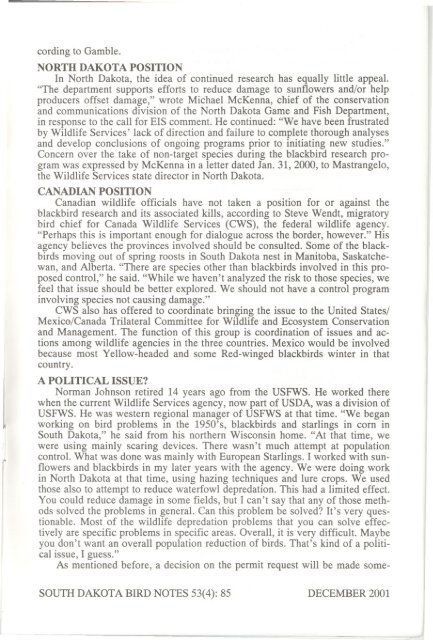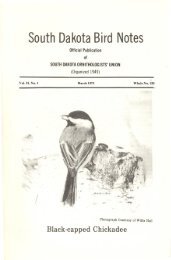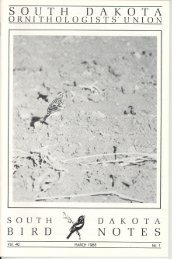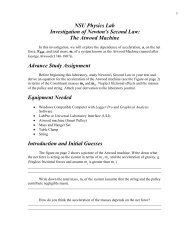possible. They are trying to make conclusions on studies impossible to carry out.I would not fault the researchers. I think they have an almost impossible task. Isthere a solution to blackbird predation? Yes, but it is not doable: Don't growsunflowers next to blackbird roosts. Cattail control is a method of reducingroosts, to try to discourage the birds. But how do you discourage people fromgrowing a profitable crop on their own land?"STUDY REVIEWING RESEARCHThe research review study mentioned by Ms. Dowd-Stukel was highly criticalof some of the work done by APHIS and WS. The review was done by Dr.Elisabeth Harrahy, a post-doctoral fellow at the Colorado Cooperative Fish andWildlife Research Unit, an operation staffed, supported, and coordinated by theColorado Division of Wildlife, the U.S. Geological Survey (Biological ResourcesDiv), Colorado <strong>State</strong> <strong>University</strong> (CSU), and the Wildlife ManagementInstitute. The unit is located at CSU.Larry Gamble, with ecological services in the USFWS Denver office, saidreview of toxicity data APHIS had provided for non-target species found whathe called "important data gaps." Dr. Harrahy was assigned to examine literatureon the effects of DRC-1339 on non-target bird species."Overall, the amount of reliable information available on the effects ofDRC-1339 on non-target birds is small," Dr. Harrahy wrote in her report. "Despitegreater than 30 years of study, one cannot justifiably say that the effects ofDRC-1339 on non-target birds have been thoroughly assessed. ...data generatedin most of the laboratory experiments should be considered preliminary orrange-finding, rather than definitive," she wrote, "because of the poor experimentaldesigns used to generate them. Fifty percent of all the experiments (laboratory,field, and outdoor pen) included in this review has experimental design'rates of 'poor' or 'useless.'" Dr. Harrahy suggested additional studies be donefor non-target bird species. She also said that because DRC-1339 is a relativelyslow-acting poison, and because carcass searches generally were conducted onlywithin bait sites and target species roosts, "finding even a few dead non-targetbirds may indicate substantial mortality."The analysis in Dr. Harrahy's report was critically flawed, its main conclusionsuntenable, wrote Mark Tobin, program manager for Wildlife Services, FortCollins, Colorado, in a letter to Larry Gamble after review of the Harrahy study."This selective review omits or fails to seriously discuss several important studiesbearing on the effect of DRC-1339 to non-target birds," he wrote. "Also absentfrom the report is an in-depth analysis or discussion of acute dietary toxicitytests with caged birds exposed to formulated baits, standardized diets, or poisonedcarcasses. ... Finally, the review makes no mention of the fact that DRC-1339 has met all the registration requirements of the Environmental ProtectionAgency." He concluded his letter by saying the Harrahy report is "superficialand incomplete to the point of lacking credibility. ...DRC-1339 has been usedoperationally in the U.S. since 1967 without any evidence of major non-targetkills." He mentioned that acute toxicity tests for Tree Sparrows, meadowlarks,Horned Larks, and Dark-eyed Juncos, and dietary tests for Savannah and Treesparrows, meadowlarks, Canada and Snow geese, and <strong>Northern</strong> Cardinals recentlywere completed. In a telephone conversation he said results of these testsare not yet available. These studies were done at the request of USFWS, ac-SOUTH DAKOTA BIRD NOTES <strong>53</strong>(4): 84 DECEMBER <strong>2001</strong>
- ,..,rcording to Gamble.NORTH DAKOTA POSITIONIn North Dakota, the idea of continued research has equally little appeal."The department supports efforts to reduce damage to sunflowers and/or helpproducers offset damage," wrote Michael McKenna, chief of the conservationand communications division of the North Dakota Game and Fish Department,in response to the call for EIS comment. He continued: "We have been frustratedby Wildlife Services' lack of direction and failure to complete thorough analysesand develop conclusions of ongoing programs prior to initiating new studies."Concern over the take of non-target species during the blackbird research programwas expressed by McKenna in a letter dated Jan. 31,2000, to Mastrangelo,the Wildlife Services state director in North Dakota.CANADIAN POSITIONCanadian wildlife officials have not taken a position for or against theblackbird research and its associated kills, according to Steve Wendt, migratorybird chief for Canada Wildlife Services (CWS), the federal wildlife agency."Perhaps this is important enough for dialogue across the border, however." Hisagency believes the provinces involved should be consulted. Some of the blackbirdsmoving out of spring roosts in South Dakota nest in Manitoba, Saskatchewan,and Alberta. "There are species other than blackbirds involved in this proposedcontrol," he said. "While we haven't analyzed the risk to those species, wefeel that issue should be better explored. We should not have a control programinvolving species not causing damage."CWS also has offered to coordinate bringing the issue to the United <strong>State</strong>s/Mexice/Canada Trilateral Committee for Wildlife and Ecosystem Conservationand Management. The function of this group is coordination of issues and actionsamong wildlife agencies in the three countries. Mexico would be involvedbecause most Yellow-headed and some Red-winged blackbirds winter in thatcountry.A POLITICAL ISSUE?Norman Johnson retired 14 years ago from the USFWS. He worked therewhen the current Wildlife Services agency, now part of USDA, was a division ofUSFWS. He was western regional manager of USFWS at that time. "We beganworking on bird problems in the 1950's, blackbirds and starlings in com inSouth Dakota," he said from his northern Wisconsin home. "At that time, wewere using mainly scaring devices. There wasn't much attempt at populationcontrol. What was done was mainly with European Starlings. I worked with sunflowersand blackbirds in my later years with the agency. We were doing workin North Dakota at that time, using hazing techniques and lure crops. We usedthose also to attempt to reduce waterfowl depredation. This had a limited effect.You could reduce damage in some fields, but I can't say that any of those methodssolved the problems in general. Can this problem be solved? It's very questionable.Most of the wildlife depredation problems that you can solve effectivelyare specific problems in specific areas. Overall, it is very difficult. Maybeyou don't want an overall population reduction of birds. That's kind of a politicalissue, I guess."As mentioned before, a decision on the permit request will be made some-SOUTH DAKOTA BIRD NOTES <strong>53</strong>(4): 85 DECEMBER <strong>2001</strong>
- Page 1:
I .SOUTH DAKOTA IORNITHOLOGISTS'UNI
- Page 4 and 5:
fication of Birds of North America
- Page 6 and 7:
- - ~1180 individuals banded and 20
- Page 8 and 9:
L--: --..Dean, K. L. 1999. Stopover
- Page 10 and 11:
I was listening to an unusual sparr
- Page 12 and 13:
..of Black-backed Woodpeckers incre
- Page 14 and 15:
.~24 Sep Meade JLB ... Late [l5-Nov
- Page 16 and 17:
..-- --- --Yankton SVS; 02 Aug Robe
- Page 18 and 19:
..American Tree Sparrow Early: 03 O
- Page 20 and 21:
PubUshed bySOUl1l DAKOTAORNI1HOLOGI
- Page 22 and 23:
SOUTH DAKOTA BIRD NOTES, the offici
- Page 24 and 25:
..ess that is being fought against.
- Page 26 and 27:
White-fronted Goose 13% 6Snow Goose
- Page 28 and 29:
Hairy Woodpecker 91% 41Black-backed
- Page 31 and 32:
- - -Grzybowski, 1. A. 1999. Southe
- Page 33 and 34: en0ẹ..,::r:t:J~0~OJ....:;.:;t:JZ0
- Page 35 and 36: ~A GUIDE TO THE BIRDS OF THE PHILIP
- Page 37 and 38: Brookings KIE; 11 Feb Hughes RDORed
- Page 39 and 40: TJ; 20 Jan Hughes JSP, RFSPurple Fi
- Page 41 and 42: ~!I: ORNITHOLOGISTS'I SOUTH DAKOTAU
- Page 43 and 44: ..~PRESIDENT'S PAGEI had such a bla
- Page 45 and 46: -erably prior to consulting a field
- Page 47 and 48: SUBMITTEDFOR CONSIDERATIONEurasian
- Page 49 and 50: '"young cormorants, near flight sta
- Page 51 and 52: - --"only one genus of the family S
- Page 53 and 54: ~SEASONAL REPORTSThe 2001 Spring Se
- Page 55 and 56: ----KM; 08 Apr Butte JLBCinnamon Te
- Page 57 and 58: ,-----0Apr Minnehaha RBA; 17 May Be
- Page 59 and 60: Pileated Woodpecker Only Report: 15
- Page 61 and 62: 07 MayUnion RBA ...Late: 12 May McC
- Page 63 and 64: ,I~haha RFS, JSP; 11 May Meade EEMB
- Page 65 and 66: Contributing ObserversRBADBJLBKBAPB
- Page 67 and 68: .~lSD State Lists (31 December 2000
- Page 69 and 70: - ---- JSOU T H D A K 0 r~ORNITHOLO
- Page 71 and 72: ...~PRESIDENT'S PAGEThe September m
- Page 73 and 74: emained at the refuge for 11 days b
- Page 75 and 76: _INelson has cut back sunflower pla
- Page 77 and 78: problems." He explained that Wildli
- Page 79 and 80: within two hours.) Some non-target
- Page 81 and 82: '\of USFWS, Mountain-Prairie Region
- Page 83: takes three days for the bird to di
- Page 87 and 88: ~IrSMALL RESEARCH GRANTS AVAILABLE
- Page 89 and 90: ';IWhite-faced Ibis reported from H
- Page 91 and 92: Whip-poor-will Reported from Lincol
- Page 93 and 94: Meade, Pennington and Stanley co.Ea
- Page 95 and 96: REPRFSSSNSSVSDRSDSRandy E. PodollRo
















